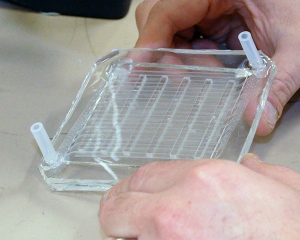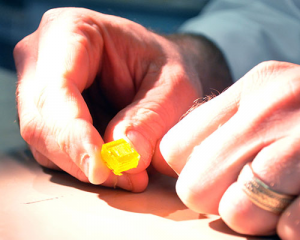 We often see 3D printing used to make a difference in the lives of our veterans, whether it’s creating customized prosthetic attachments and covers, helping them get back to work, or simply providing a good pair of shoes. Now, scientists at the VA Ann Arbor Health Care System in Michigan are developing a 3D printed artificial lung that could help treat veterans affected by lung disease.
We often see 3D printing used to make a difference in the lives of our veterans, whether it’s creating customized prosthetic attachments and covers, helping them get back to work, or simply providing a good pair of shoes. Now, scientists at the VA Ann Arbor Health Care System in Michigan are developing a 3D printed artificial lung that could help treat veterans affected by lung disease.
Chronic obstructive pulmonary disease (COPD) is one of the most prevalent, and expensive, illnesses currently affecting US veterans, with 16% of the veteran population suffering – some of the most common factors leading to lung issues for active-duty military include exposure to burn pits, chemicals, diesel exhaust, and sand. According to the VA’s Office of Research & Development, most people with COPD have emphysema (enlarged and damaged lung air sacs) and chronic bronchitis, and about 20% of patients with severe traumatic brain injuries also suffer from acute lung injuries.

Biomedical engineer Dr. Joseph Potkay, with the VA Ann Arbor Health Care System, displays a 2D prototype of an artificial lung. A 3D version is in production.
Biomedical engineer Dr. Joseph Potkay is leading the research, which is funded by the VA and focused on patients who have a buildup of CO2 in their blood, which often applies to veterans with end-stage COPD; this can lead to sudden cardiac death, so any excess CO2 needs to be removed from the lungs so it doesn’t get to this point.
Dr. Potkay has long been researching the advantages of using microfabrication to build artificial lungs with efficient gas exchange and blood paths similar to those in human lungs. He introduced a 2D printed artificial lung prototype back in 2011, made using traditional microfabrication methods with help from Case Western Reserve University and the Advanced Platform Technology Center at the Louis Stokes Cleveland VA Medical Center. The unique prototype was efficient enough to use air, instead of pure oxygen, as a ventilating gas, which opens up new possibilities for potential implantation. Dr. Potkay says that the 3D printed version currently in the works will “provide the same basic advantages.”
Dr. Potkay said, “But with the freedom afforded by being able to design the device in three dimensions instead of two, 3D printing should result in artificial lungs with a smaller overall footprint and with increased efficiency. Thus, portability and performance will potentially improve using 3D printing.”

Potkay’s artificial lung model relies on microfabrication to achieve highly efficient gas exchange and blood paths similar to those in a human lung.
Dr. Potkay and his team are working with high-resolution 3D printing company Old World Labs to create a prototype of the 3D printed artificial lung, which will be about a half-inch cube in size, hopefully able to fit in a backpack and be used for a week; however, after further development, the hope is to get the lung to work for longer amounts of time.
Lung disease patients have long used heart-lung machines that contain artificial lungs for rehabilitation, but the devices are bulky and, according to Dr. Potkay, “not truly portable.” Additionally, they also have to maintain appropriate blood pressure, minimize clotting and immune response and reduce blood cell injuries.
The goal behind the VA research is to create the first truly wearable artificial lung that’s compatible with living tissue and can provide both short- and long-term respiratory support, and microfluidic artificial lungs also use far less blood than current commercial devices do. According to Dr. Potkay, this is the first time that high-resolution polymer 3D printing has been used to fabricate microfluidic lungs with 3D blood flow networks.
“With a 2D design, you stack many single 2D layers together. That has limited the ease of creating devices that are large enough for human use. You have less freedom in how you design the blood channels,” Dr. Potkay explained. “3D printing these devices may be a solution to these problems. We can be much more precise and efficient with how the blood flow path is laid out in three dimensions.
“We hope that these microfluidic flow paths and biocompatible coatings will be more compatible with living tissue, thereby reducing the body’s immune response and increasing the lifetime of the device. The flexibility in design afforded by 3D printing gives us more freedom and thus the ease to build artificial lungs with a small size and pressure drops that are compatible for operation with the body’s natural pressures.”

Potkay works with a test print of artificial capillaries that will be part of a 3D artificial lung now in production.
Dr. Potkay is not sure yet how far away we are from implanting 3D printed lungs, and explained that the device was currently only being tested in rabbits, with sheep testing planned for the future.
“We’ll see how well it does in terms of lifetime. To be implantable, it needs to be able to operate for months without being swapped out,” Dr. Potkay explained.
“Although the 3D artificial lung is more promising, it is earlier in development and still not guaranteed to work. We’re further along in developing the 2D device, and we have plans to work around the challenges with that device.”
Tests with traditional microfabrication techniques and animal blood showed that the 2D small-scale artificial lungs had the “highest gas efficiency exchange of any artificial lung to date,” and Dr. Potkay believes that this will also translate to the 3D printed version; additionally, the expected lifetime of the 2D lung has “significantly improved” due to its biocompatible surface coatings.
Dr. Potkay said, “We believe the 3D-printed device should be better than the 2D version, but we don’t have proof yet.”
The 3D printed lung could also be used as a temporary solution for people with other lung diseases, like acute respiratory distress syndrome.
“It will depend largely on the needs of the patient. The removal of CO2 in the blood is the first Veteran application we’re aiming for because it’s the simplest in terms of patient use, the required components, and the size of the device. CO2 removal is a critical need for many Veterans with COPD,” Dr. Potkay said.
Discuss this and other 3D printing topics at 3DPrintBoard.com or share your thoughts below.
[Images: Brian Hayes]Subscribe to Our Email Newsletter
Stay up-to-date on all the latest news from the 3D printing industry and receive information and offers from third party vendors.
You May Also Like
3D Printing News Briefs, April 13, 2024: Robotics, Orthotics, & Hypersonics
In 3D Printing News Briefs today, we’re focusing first on robotics, as Carnegie Mellon University’s new Robotics Innovation Center will house several community outreach programs, and Ugogo3D is now working...
Rail Giant Alstom Saves $15M with 3D Printing Automation Software 3D Spark
3D Spark has entered into a three-year deal with the rail giant Alstom. Alstom, a transport behemoth with annual revenues of $16 billion, specializes in the manufacture of trains, trams,...
Meltio Expands Global Reach with New Partnerships in the Americas and Europe
Spanish 3D printing manufacturer Meltio has expanded its sales network across the globe. With the addition of three new partners in the United States, Brazil, Argentina, and Italy, Meltio aims...
3D Printing Webinar and Event Roundup: April 7, 2024
Webinars and events in the 3D printing industry are picking back up this week! Sea-Air-Space is coming to Maryland, and SAE International is sponsoring a 3D Systems webinar about 3D...































